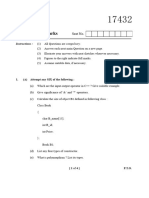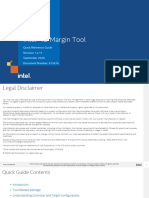BCA 3 Semester Exam 2014 Object-Oriented Programming Using C++ Code-303301
Uploaded by
ANURAG KashyapBCA 3 Semester Exam 2014 Object-Oriented Programming Using C++ Code-303301
Uploaded by
ANURAG KashyapPage 1 of 2
onlineqp.com
BCA 3rd SEMESTER EXAM. 2014
OBJECT-ORIENTED PROGRAMMING USING C++ CODE- 303301
Time: 3 hours Full Marks: 60
Instructions:
i. The Marks are indicated in the right -hand margin.
ii. There are SEVEN questions in this paper.
iii. Attempts FIVE question in all.
iv. Question Nos. 1 and 2 are compulsory.
1. Answer the following as directed (any six). 6*2=12
(a) Base class pointer cannot point to derived class
(State True or False)
(b) Which of the following is not the member of class
(I) Static function (II) Friend function
(III) Const function (IV) Virtual function
(c) Which of the following access specifies is used in a class definition by default?
(I) Protected (II) Pubic
(III) Private (IV) Friend
(d) What happens when a class with parameterized constructor and having no default
Constructor is used in a program and we create an object that needs a zero-
arguments constructor?
(e) If the programmer does not explicitly provide a destructor, then creates an empty
destructor. (Fill In the blanks)
(f) What is the use of function call operator?
(I) Overloading the method (II) Overloading the objects
(III) Overloading the parameters (IV) none of the above
(g) Which of the following advantages we lose by using multiple inheritances?
(I) Dynamic binding (II) Polymorphism
(III) Both (i) and (ii) (IV) none of the above
akubihar.com (h) Which of the following is referred by pointers to member?
Page 2 of 2
onlineqp.com
(I) Static members of class objects (II) Non-static members of class objects
(III) Referring to whole class (IV) none of the above
(i) What does derived class not inherit from the base class?
(I) Friends (II) Operator = () members
(III) Constructor and destructor (IV) A of the above
(j) Which other keyword are also used to declare the class other than class?
(I) Struct (II) Union
(III) Object (IV) both (i) and (ii)
2. Answer any three of the following: 3*4=12
(a) What is an operator function? Describe its syntax.
(b) Explain the characters of constructor and destructor.
(c) Write syntax for overloading extraction and insertion operator with friend function.
(d) Explain the mechanism for accessing private member of the base class using pointers.
(e) Describe various errors trapping function.
Answer any three of the following: 3*12=36
3. (a) What is function overloading? What are the rules for defining overloaded functions? Precautions
should us tae while overdoing function? 6
(b) Write a program in C++ to use bit fids with cases display the contents of the objects. 6
4. (a) How are the constructor and destructor called explicitly? What is the difference between
their calling methods? 6
(b) Write a program in C++ to pass an object to constructor and carry out copy constructor
display contents of the objects. 6
5. What is operator overloading? Explain the conversion of basic data type to class type and class
type to basic type with appropriate example. 12
6. (a) Describe various type of inheritance with example. 6
(b) Write a program in C++ to declare class X Y and Z. Each class contains one character array as
a data member. Apply multiple inheritance. Concatenate strings of class X and Y and store it in Z.
Show all the three strings. Use constructor and destructor. 6
7. (a) What are templates? Explain its need. How can normal function be declared as template function?
(b) Write a program in C++ to use exception handing with constructor and destructor.
akubihar.com 6*2=12
You might also like
- GS410-6390 - B (GeoSwath 4R System User Guide)100% (2)GS410-6390 - B (GeoSwath 4R System User Guide)83 pages
- (CC-203) (Object Oriented Concepts and Programming)No ratings yet(CC-203) (Object Oriented Concepts and Programming)4 pages
- Object Oriented Programming and Desigbn Question Bank Unit - I Object and ClassesNo ratings yetObject Oriented Programming and Desigbn Question Bank Unit - I Object and Classes9 pages
- Object Oriented Programming Using C++ 2020No ratings yetObject Oriented Programming Using C++ 20202 pages
- BSC Bca 2 Sem Object Oriented Programming Using CPP 20101289 Nov 2020No ratings yetBSC Bca 2 Sem Object Oriented Programming Using CPP 20101289 Nov 20202 pages
- Institute of Information Technology and Management New Delhi-58 Question Bank-Unit I Object Oriented Programming in C++No ratings yetInstitute of Information Technology and Management New Delhi-58 Question Bank-Unit I Object Oriented Programming in C++8 pages
- BSC Bca 2 Sem Object Oriented Programming Using CPP 19101909 May 2019No ratings yetBSC Bca 2 Sem Object Oriented Programming Using CPP 19101909 May 20192 pages
- Questions Bank For III Semester 2020: - Subject: Object Oriented Programming & Methodology Subject Code: 150304 Unit-INo ratings yetQuestions Bank For III Semester 2020: - Subject: Object Oriented Programming & Methodology Subject Code: 150304 Unit-I5 pages
- Btech Cse Ece It 3 Sem Object Oriented Programming Using Cpp 56595 Nov 2019No ratings yetBtech Cse Ece It 3 Sem Object Oriented Programming Using Cpp 56595 Nov 20192 pages
- Be Computer Engineering Semester 3 2022 May Object Oriented Programming Oop Pattern 2019No ratings yetBe Computer Engineering Semester 3 2022 May Object Oriented Programming Oop Pattern 20192 pages
- Be - Electronics and Telecommunication Engineering - Semester 4 - 2022 - November - Object Oriented Programming Oop Pattern 2019No ratings yetBe - Electronics and Telecommunication Engineering - Semester 4 - 2022 - November - Object Oriented Programming Oop Pattern 20192 pages
- Be Electronics and Telecommunication Engineering Semester 4 2023 November Object Oriented Programming Oop Pattern 2019No ratings yetBe Electronics and Telecommunication Engineering Semester 4 2023 November Object Oriented Programming Oop Pattern 20192 pages
- Object Oriented Programming Through C++ Feb 2022No ratings yetObject Oriented Programming Through C++ Feb 20222 pages
- Be Computer Engineering Semester 3 2022 November Object Oriented Programming Oop Pattern 2019No ratings yetBe Computer Engineering Semester 3 2022 November Object Oriented Programming Oop Pattern 20193 pages
- Cs304-Midterm Solved Mcqs With References by Moaaz78% (9)Cs304-Midterm Solved Mcqs With References by Moaaz21 pages
- Subject: Object Oriented Programming in C++No ratings yetSubject: Object Oriented Programming in C++1 page
- HT TP: //qpa Pe R.W But .Ac .In: Programming Practices Using C++No ratings yetHT TP: //qpa Pe R.W But .Ac .In: Programming Practices Using C++4 pages
- Cs304-Midterm Solved Mcqs With Refrences by Moaaz - Formatted100% (1)Cs304-Midterm Solved Mcqs With Refrences by Moaaz - Formatted26 pages
- NX: Convert Inch Part To Metric (Or Vice Versa)No ratings yetNX: Convert Inch Part To Metric (Or Vice Versa)10 pages
- Extend Windows file servers with Azure File SyncNo ratings yetExtend Windows file servers with Azure File Sync8 pages
- Modulo 5: Resolviendo Nombres Netbios Con WinsNo ratings yetModulo 5: Resolviendo Nombres Netbios Con Wins24 pages
- ISTQB Foundation Level Exam Sample Paper 2ANo ratings yetISTQB Foundation Level Exam Sample Paper 2A3 pages
- GMB (Google My Business) Optimizer GuideNo ratings yetGMB (Google My Business) Optimizer Guide13 pages
- Intel® IO Margin Tool: Quick Reference Guide Revision 1.2.11 September 2020 Document Number: 6158760% (1)Intel® IO Margin Tool: Quick Reference Guide Revision 1.2.11 September 2020 Document Number: 61587634 pages
- ICT-LAb (4) .Docx Zoya Zaib COSC321101094No ratings yetICT-LAb (4) .Docx Zoya Zaib COSC3211010948 pages
- 70-346.examcollection - Premium.exam.110q: Number: 70-346 Passing Score: 800 Time Limit: 120 Min File Version: 9.0No ratings yet70-346.examcollection - Premium.exam.110q: Number: 70-346 Passing Score: 800 Time Limit: 120 Min File Version: 9.056 pages
- Drop Down Action in LIST UIBB - SAPCODES PDFNo ratings yetDrop Down Action in LIST UIBB - SAPCODES PDF7 pages

























































































